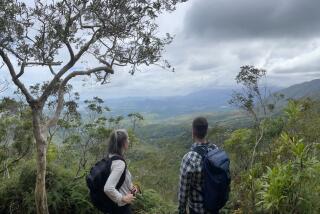Celera First With Human Genome Code
- Share via
A biotech company announced Thursday that it has deciphered the genome of a human volunteer, claiming a scientific first that was greeted by both praise and skepticism from academic scientists who point out that the job remains unfinished.
Celera Genomics, in a race with a public effort to map the human genetic code, said it has decoded millions of DNA fragments extracted from an anonymous person--the first phase of its effort to put together a so-called working draft of the genome.
Celera President J. Craig Venter said it will take an additional three to six weeks for his team to assemble the pieces for a complete genetic blueprint. If so, the company is slightly ahead of its competition, the publicly funded Human Genome Project.
The company’s achievement is akin to taking millions of random satellite photographs of small sections of North America. The next step is assembling them into a complete map.
When it is done, Celera’s draft is likely to have “zillions of statistical gaps,” said Eric Lander, director of the Whitehead Center for Genome Research, the largest government-funded gene sequencing center in the U.S. To close those gaps, Lander said, Rockville, Md.-based Celera, a unit of PE Corp., will have to rely on the public database updated daily on the Internet and now about 75% complete.
Deciphering the genome is expected to help medical researchers unlock the secrets of major illnesses, such as cancer and heart disease, provide new treatments for a host of ailments and perhaps even forestall the effects of aging itself.
The company’s announcement comes at a time of political and financial turmoil for the biotech industry, prompting critics to question whether the announcement had more to do with business than science.
A month ago, share prices of Celera and other genomic companies plummeted after President Clinton and British Prime Minister Tony Blair issued a joint statement, declaring that raw genetic information should be freely available to everyone and should not be patented. Earlier this week, the stocks rebounded after the president took responsibility for the crash, saying he had been misinterpreted and reaffirming U.S. policy that allows companies to patent their genetic discoveries.
With biotech stocks soaring or swooning depending on the news of the day, Celera got another boost from its latest announcement--up 24% at the close of trading Thursday.
“Now that we have completed the sequencing of one human being’s genome, we will turn our computation power to the task of ordering the human genome,” Venter said in a company news release. The completed genome, he said, “is expected to allow researchers worldwide and our subscribers to utilize our data to make important medical advances.”
Celera’s map will be based on the genome of just one individual, but any one person’s genetic code is 99.9% like that of any other. Eventually, Celera plans to gather data from five other people of varied ethnic backgrounds to capture many of the individual differences.
The announcement came on the same day that Venter appeared before the House Science Committee’s energy and environment subcommittee, where he was warmly received. In his remarks, Venter expressed some of the increasing bitterness between his team and the Human Genome Project.
“I find myself in the peculiar position of warning you,” he told the representatives, that the public effort “may be at a stage where quality and scientific standards are sacrificed for credit.”
Dr. Francis S. Collins, head of the National Human Genome Research Institute, which oversees the public effort, denied the allegation.
Collins, who was not present at the hearing, defended the public effort, saying, “Our sequencing and its deposit in the public domain has already led to the discovery of over a dozen disease genes that would otherwise not have been discovered.”
There is little doubt that Celera has produced an amazing amount of raw data since it began its human genome effort in early September, using 300 of the latest sequencing machines running around the clock and backed by a phalanx of supercomputers.
The genetic code of all living things is contained in long DNA molecules, which contain the instructions that direct the growth and maintenance of every cell. Scientists write out the code in a four-letter chemical alphabet--As, Ts, Cs and Gs--which represent the compounds that make up DNA.
The human genome is about 3 billion letters long. To write it out would take some 500,000 pages of small print.
The Human Genome Project and Celera have deployed different strategies for decoding the genome.
Richard A. Gibbs, director of the Human Genome Sequencing Center at Baylor College of Medicine, compares the process to making a giant aerial photo of the entire U.S. by randomly shooting millions of small, overlapping photographs and then assembling them into a final picture. The more snapshots, the more complete and accurate the photo map will be.
The publicly funded project, Gibbs said, divides the “continent”--in this case, the genome--into manageable subdivisions, each with markers that make it easier to assemble a complete photographic map. That, he said, is necessarily a slow process, but it will result in a completed genome that has few gaps and is highly accurate.
In contrast, Gibbs said, Celera’s approach is to take all the smaller photographs at once, without establishing markers, and hope there are enough overlapping features to complete the job.
Still he concedes, “The data could be important, if it’s released.”
The Celera database, however, is proprietary, available for now only to paying customers, which are mostly pharmaceutical companies. The company has promised to give access to academic researchers as long as they agree not to release the information to Celera’s competitors.






